Last week, North Korea’s foreign minister floated the prospect of testing a hydrogen bomb in the Pacific Ocean in response to President Donald Trump’s threat of “total destruction” of the Asian nation in a speech to the United Nations. Such a test, whether in the open air or underwater, would be the first of its kind in almost four decades.
But even before a hydrogen bomb test could trigger the fallout of international war, the blast would cause immediate damage to marine life and space technology like satellites and space stations.
What will that look like? The full repercussions depend largely on the science of the bomb, into which we have plenty of insight thanks to the 500 or so nukes detonated above ground from 1945 to 1980. Here’s a closer look at what a hydrogen bomb could mean for sea creatures, fisheries, astronauts and even Google Earth.

Since 1945, more than 2,000 nuclear explosive tests have been carried out around the world. Graphic by Reuters
Scenario 1: A hydrogen bomb explosion below the Pacific Ocean surface
In some ways, the best-case scenario would be an underwater detonation of a hydrogen bomb — at a great depth, in a remote portion of the Pacific Ocean.
Sure, a bubble of hot gas and a shock wave from the blast would devastate all marine life in the immediate vicinity. In July 1946, two nuclear weapons tests at Bikini Atoll — codenames Able and Baker — killed 38,000 fish, with the most extensive damage caused by Baker’s underwater detonation. But water can also limit the spread of a bomb’s radioactive emissions and stop its electromagnetic pulse (EMP), a burst of energy capable of crippling unshielded electronic devices.
The extent of a bomb’s radioactive pollution is determined by its design and also where it lands. A fission bomb, like those dropped on Nagasaki and Hiroshima during World War II, use uranium and plutonium to split atoms, creating a chain reaction that produces more radioactive material and generates a giant explosion. But most of the radioactive fuel in a fission bomb goes unused, meaning what’s left can enter the environment.
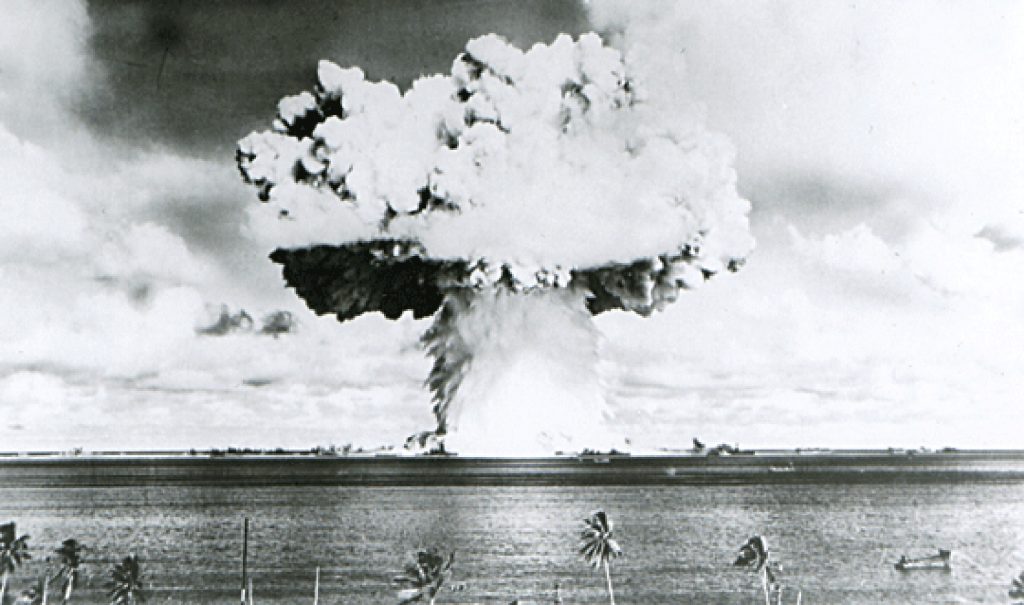
This U.S. Navy handout image shows Baker, the second of the two atomic bomb tests, in which a 63-kiloton warhead was exploded 90 feet under water as part of Operation Crossroads, conducted at Bikini Atoll in July 1946 to measure nuclear weapon effects on warships. Photo by REUTERS/U.S. Navy/Handout via Reuters
A hydrogen bomb, by contrast, releases less radioactivity, said Nicholas S. Fisher, a marine biogeochemist at Stony Brook University. The device’s blend of fission and fusion — by combining hydrogen atoms — consumes most of its radioactive fuel. The result is a much bigger explosion. We saw this after North Korea’s alleged H-bomb test in early September. Estimates vary, but the explosive force in that test may have been up to 280 kilotons — 14 times stronger than Hiroshima.
If a similar bomb was detonated in the Pacific Ocean, Fisher estimates the residual radioactivity would be less than what was released during the weapons testing period of the 1960s.
“Since you can’t smell or feel or taste the radioactivity, if people think even small amounts are in their food, they panic. Sometimes panic is the proper response, and sometimes it’s not needed if the levels are low enough.”So, what does this mean for the future of your sushi? It depends on the proximity of the fish to the detonation site. Radiation levels at Bikini Atoll and other Marshall Islands, where the U.S. tested 67 atomic bombs in the 1940s and 1950s, are nearly double what is considered safe for human habitation. Most corals survived these blasts, but 42 species became locally extinct.
However, this radiation posed less danger to marine animals and fisheries farther away.
“Imagine you dropped some dye in a bathtub and swirled your hand around,” said marine geochemist Ken Buesseler, who directs the Center for Marine and Environmental Radioactivity at the Woods Hole Oceanographic Institution. “At first you’d see the spot pretty clearly, and then over time it’s going to be mixed around. Less and less will show up.”
Ocean currents have the same effect on radioactive material, which is only dangerous to organisms in large quantities. “Every bit of ocean now has some residual radioactivity in it from those bombs in the 1960s,” Buesseler said, but its concentration is too low to cause problems.
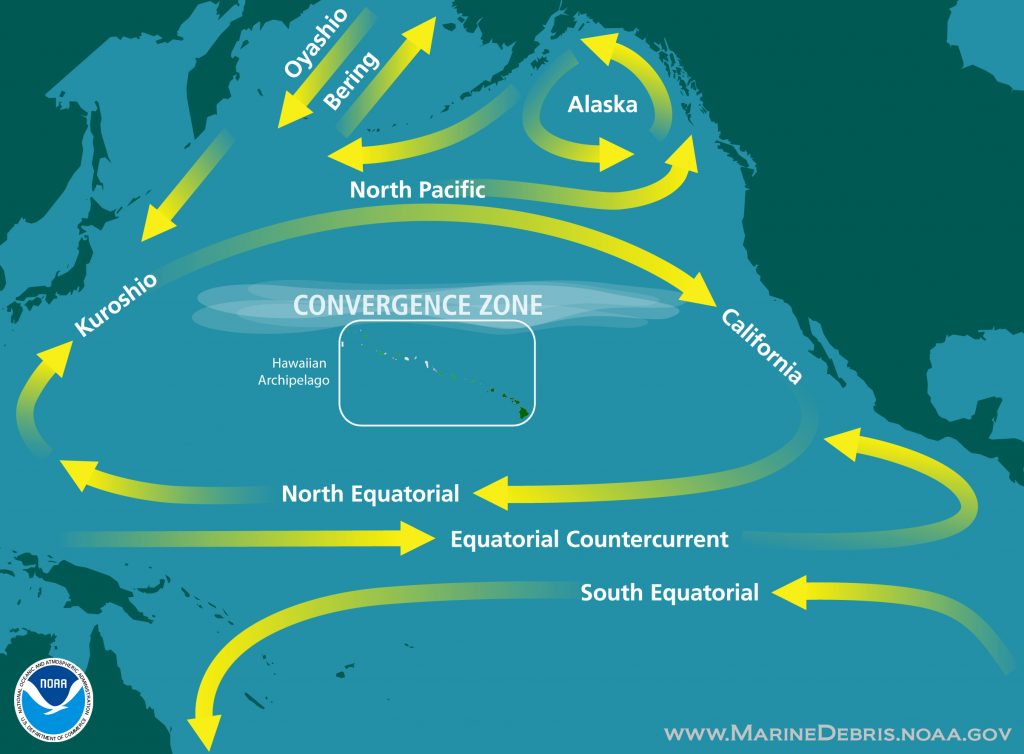
Map of North Pacific Ocean currents. Radiation from the Fukushima disaster took more than two years to cross from Japan to the West Coast. Chart by NOAA
Plus, this residual contamination pales in comparison with naturally-occurring radiation. Bananas are radioactive. Our bodies are naturally born radioactive. In fact, the entire catalog of nuclear weapons testing in the world amounts to one percent of the radioactivity in the ocean; the rest is natural, Fisher said.
Here’s the thing. Even if the radiation spread is minimal, it will still cause fear. Both Fisher and Buesseler led investigations into how Fukushima disaster affected the seas near Japan and the U.S. Radioisotopes infiltrated plankton and small fish close to the power plant within weeks of the crisis, and nearby fisheries have been heavily regulated ever since. But even though tuna carried portions of this radiation to the West Coast within months, the levels in food and water were still way below safety limits.
“A lot of this is going to be more psychological than the radiological hazard,” Buesseler said. “Since you can’t smell or feel or taste the radioactivity, if people think even small amounts are in their food, they panic. Sometimes panic is the proper response, and sometimes it’s not needed if the levels are low enough.”
Scenario 2: A hydrogen bomb explosion in the air
The threat calculus changes sharply if the hydrogen bomb explodes in the air or just below the ocean’s surface. For one, if the atmospheric detonation happens in the North Pacific, where North Korea’s recent missile tests have landed, wind currents would carry the radiation to the U.S. in a matter of days and eventually all over the world. Again, the health fallout would depend on the amount of fission and how much leftover radioactivity reaches populated areas.
In response to inquiries: Rough simulation (Sept15-29) of #radio-isotope cloud from hypothetical atmospheric burst over Pacific: #CTBT #IMS pic.twitter.com/361ZBkoUy7
— Lassina Zerbo (@SinaZerbo) September 28, 2017
The altitude at which the bomb is detonated also poses a risk to satellites and astronauts in space stations. In July 1962, the U.S. executed “Starfish Prime,” a hydrogen bomb test 240 miles into the atmosphere that was 100 times stronger than Hiroshima and created an artificial aurora 4,000 miles away over Australia.
“X-rays or gamma rays from the weapon will hit the satellite and create an electromagnetic pulse that can burn out sensitive electronics…”It damaged at least eight satellites, including the world’s first telecommunication satellite, Telstar 1, which failed four months later.
Part of the problem was that Starfish Prime’s high altitude put it near the orbits of low-earth satellites, according to Laura Grego, a physicist and nuclear weapons expert with the Union of Concerned Scientists.
“There are two ways that a high altitude nuclear explosion affects satellites. One is direct line of sight. ” Grego said. “X-rays or gamma rays from the weapon will hit the satellite and create an electromagnetic pulse that can burn out sensitive electronics, and charged particles can damage mirrored coatings.”
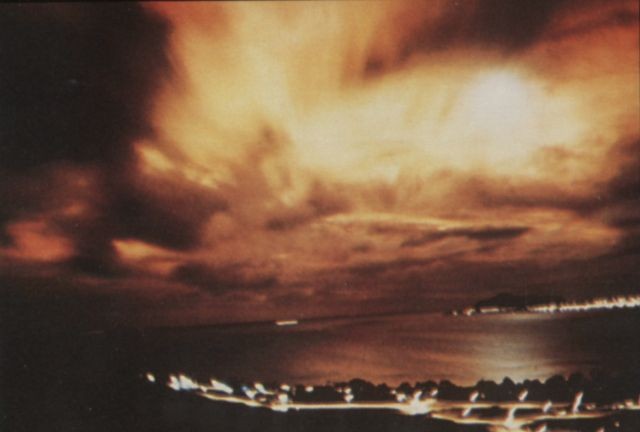
The flash created by 1.4 megaton Starfish Prime hydrogen bomb explosion as seen through heavy cloud cover from Honolulu 1,445 km away. Photo via Wikimedia
The second problem is a high-altitude blast dumps high energy electrons into the Van Allen Radiation Belts, a donut-shaped zone of charged particles encapsulating the planet. Natural events — like solar flares — fill these belts like a bucket, and once full, the particles leak out. Satellites degrade bit by bit when they pass close to these belts near the Earth’s poles. Engineers budget for this during construction. But extra spillover from the leaky radiation belts would change the equation.
“It would raise the radiation exposure of basically all low-Earth orbiting satellites and that can end up being very destructive too,” Grego said. “Some satellites, if they’re not well shielded, will fail in a matter of days or weeks. The ones that are better shielded, like military ones, would last for years.”
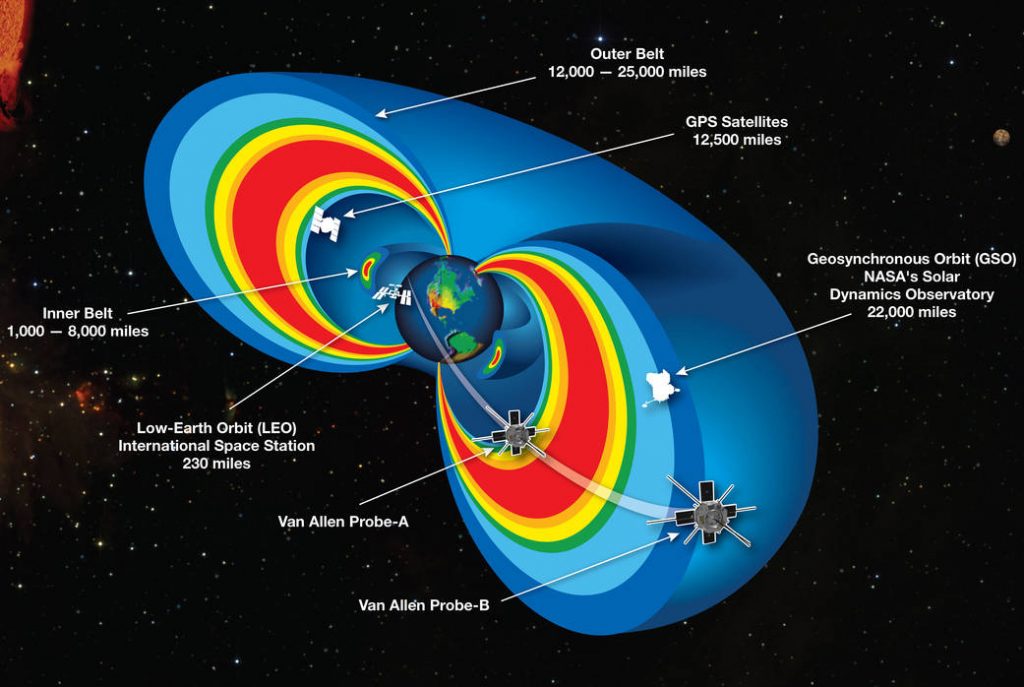
A cutaway model of the radiation belts with the 2 Van Allen Probes satellites flying through them. The radiation belts are two donut-shaped regions encircling Earth, where high-energy particles, mostly electrons and ions, are trapped by Earth’s magnetic field. This radiation is a kind of “weather” in space, analogous to weather on Earth, and can affect the performance and reliability of our technologies, and pose a threat to astronauts and spacecraft. The inner belt extends from about one to eight thousand miles above Earth’s equator. The outer belt extends from about 12 to 25 thousand miles. This graphic also shows other satellites near the region of trapped radiation. Photo and caption by NASA
The 800 or so low-earth satellites in existence track our weather, map our planet (Google Earth), control our telecommunications and collect intelligence to keep tabs on our enemies. Grego estimated a high-altitude explosion would instantly fry 5 to 20 percent of these devices, while leaks from Van Allen Radiation Belts would continue to affect current and future satellite projects for years. GPS satellites, which orbit much higher, would likely be spared.
“Vestiges of Starfish Prime’s radiation may still exist today,” said Philip Coyle, a recognized expert on worldwide military research who led the Pentagon’s weapons testing during the Clinton administration.
Grow your mind
Subscribe to our Science Newsletter to explore the wide worlds of science, health and technology.
Coyle said electronics and solar panels on the International Space Station and China’s Tiangong-2 could fail due to the EMP, given both have low-earth orbits. Grego added that depending on the size of the blast, the astronauts may also experience lethal radiation poisoning.
But an EMP from a 280-kiloton North Korean bomb would be proportionately much smaller than Starfish, Coyle said. The risk toward space technology also drops with altitude.
“If the weapon detonated near the surface of the ocean, it might have no effect on satellites because the atmosphere would interfere with gamma rays and electrons from the nuclear explosion,” Coyle said. However, the EMP could affect boats, planes or nearby cities, though some modern electronics and vehicles may survive.
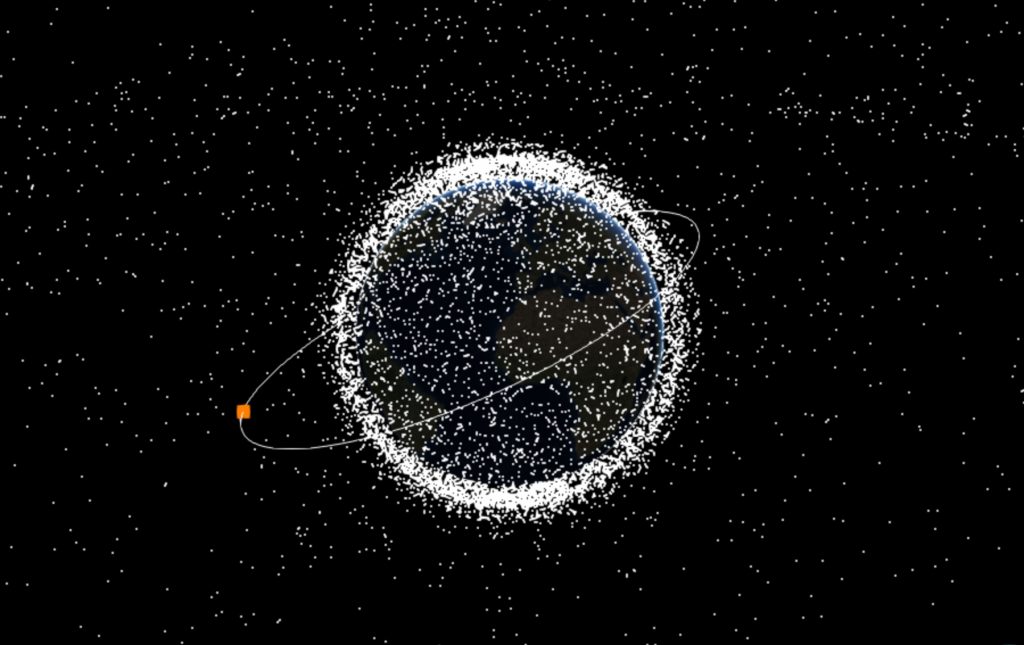
The Union of Concerned Scientists lists 1,459 operating satellites, though another 11,600 float around Earth as space junk. Click here for an interactive. Image by ERIS
“You would never want to be below a nuclear weapon detonation,” Grego said. “A standard practice, even for ballistic missile launches, is to provide a notice to mariners to stay out of the hazard zone of dropping rocket stages.”
The most concerning part, Buesseler said, is even if North Korea straps their hydrogen bomb to a missile and targets the Pacific Ocean, they may miss their mark. A number of their ballistic missile boosters have failed after launch. Of the 1,000 nuclear tests conducted by the U.S., only one involved a missile.
“It’s not an easy thing to shoot off a missile like this without having accidents,” Buesseler said. “Keeping it away from populations and below the surface the ocean would limit human exposure, but let’s just hope this never happens.”
ncG1vNJzZmivp6x7sa7SZ6arn1%2Bjsri%2Fx6isq2ejmLamusKeZqenoqm1brfOq5yaZZiusbO7xp6lZpqfoq9uvMCcoJ%2Bhk2K8pLHAp2SsqJGYsm6%2F05qroqeeqA%3D%3D